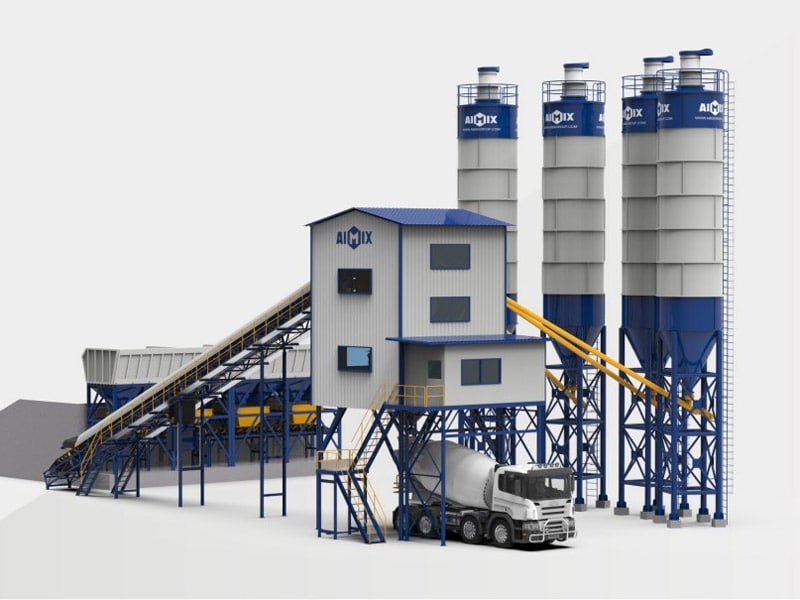The concrete mixer is the machine used to produce concrete. The purpose of the mixer is to mix the concrete components as per requirement/specification.
Depending on the type of concrete mixer, the method of adding materials to the mixing vessel varies. There may be manual methods or automated systems that simplify the process.
Concrete production
Ingredients such as water, cement and coarse and fine aggregates are used in the production of concrete.
First we produce the cement and use the necessary types of cement . The next step is mixing the concrete. This process is also called Mixing design . Once the mix design is complete, we can proceed with the production of the concrete mix.
Once production is complete, we transport the concrete to the construction site and concrete and compact it as necessary. Concrete hardening is carried out for at least 7 days and the concrete curing method depends on the type of structure.
Common Types of Concrete Mixers
The classification of the concrete mixer is based on its type. Basically, there are two types of concrete mixers.
- Continuous mixer
- Batch Mixer
Let's discuss each mixing method in detail.
Continuous mixer
The continuous concrete mixer is the metering plate that we use to make concrete. The process is continuous and we can deliver the concrete without interruption. It contains automated systems and in some mixers almost all operations are carried out automatically.
Almost all scammers


Some mixers require a person to load the material into the mixing container. We can adjust the weight of each material according to the composition of the mixture. Then just press the corresponding button to load the material into the container, mix it and unload it into the mix truck.
A continuous concrete mixer is mainly used for mass production. If it is necessary to produce large quantities of concrete, we can have a concrete batching plant on site. Furthermore, there are concrete batching plants at various locations to supply concrete as per the industry's needs.
Batch Mixer
Small-scale concrete production is usually done with batch mixers. This type of concrete mixers are very popular in the construction industry and are mainly used to produce low-quality structural and non-structural concrete.
In general, it is not recommended to produce concrete with a grade above 30 unless there is a method to maintain the accuracy and consistency of mix proportions while mixing the concrete.
Different types of concrete mixers are used to produce concrete. The categorization is based on the type of concrete mixer and its operation.
-
Concrete Drum Mixer
- Tilting drum
- Non-tilting drum
- Reversible drum mixer
- Pan mixer
We will discuss each type of concrete mixer and its functioning and limitations in detail.
Tiltable drum mixer
This type of concrete mix is used in construction, road construction and other small works. Furthermore, the concrete drum mixer is mainly used to produce low-quality concrete.
The tiltability is the reason for the name tiltable drum mixer. First we have to place all the ingredients in the concrete drum. Water is added during mixing. Please note that it is your responsibility to ensure that the correct quantities of each material are used in each batch.


If we are unable to maintain consistency in the mix throughout the concreting process, problems may arise with the strength of the concrete.
This mixer is powered by an electric motor. Once mixing is complete, the drum is turned down while rotating in the opposite direction. The concrete can then be removed for concreting.
Non-tilting drum concrete mixer
The concrete mixer works in a similar way to the tilting drum concrete mixer.
The main difference between this device is that it cannot be tilted. It rotates only to mix the concrete and cannot be rotated in any other direction.
Emptying is done by turning the mixer in the opposite direction or by inserting the chute into the drum.
Reversible drum mixer


This type of mixer represents a further development of non-tilting drum mixing. In a non-tilting mixer, we remove the pre-mixed concrete and fill the materials.
However, the mixing drum reversal was developed to facilitate the removal of mixed concrete. Concrete can be removed in the opposite direction. This means we put ingredients in from one direction and take them out from the other direction.
Pan mixer
Instead of a drum, a pan is used to mix the concrete. The mixing process and introduction of ingredients are the same as drum mixers.
The pan contains paddles to improve the mixing of the concrete. A concrete mixer is suitable for producing large quantities of concrete as long as the consistency of the concrete mix is maintained.
This allows wet and dry mixtures to be mixed. The mixing tank is movable and can be tilted after mixing to remove the concrete.


In addition, other different types of concrete mixing machines can be manufactured, which can be individually adapted depending on the purpose of the work and the conditions of the construction site.
The selection of the type of concrete mixer must be based on the work to be carried out and taking into account the ease of work.
Related articles
- Mas Concrete
- Laminated concrete
- Self-compacting concrete
- concrete
- All about concrete
- Concrete construction
- Reinforced concrete
- Ready-made concrete
- Advantages and disadvantages of reinforced concrete
- How to choose the quality of concrete
- Concrete properties
- Additive Testing
- What is concrete spalling – causes and repairs
- 20 factors that affect the durability of concrete
- Durability of concrete (requirements and problems)
- Concrete shaking (methods and correct procedure)
- 6 Factors That Affect Concrete Curing Time
- 11 Methods for Hardening Concrete
- A detailed study of concrete (from scratch)
- Types of concrete shrinkage (detailed study)

